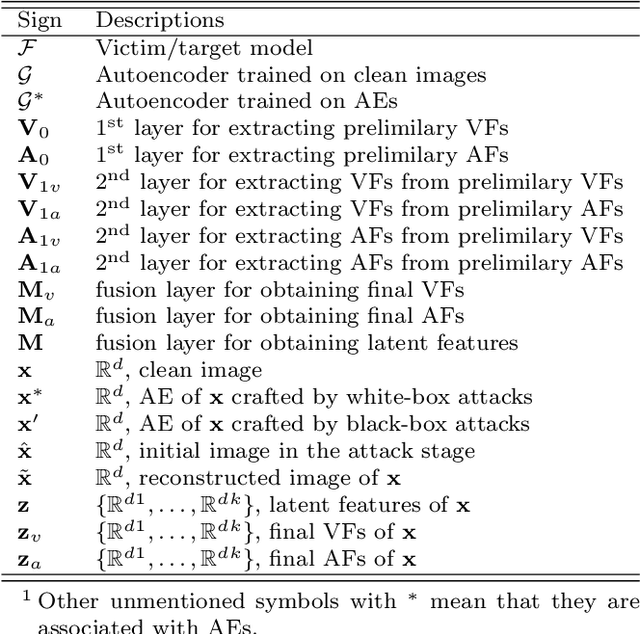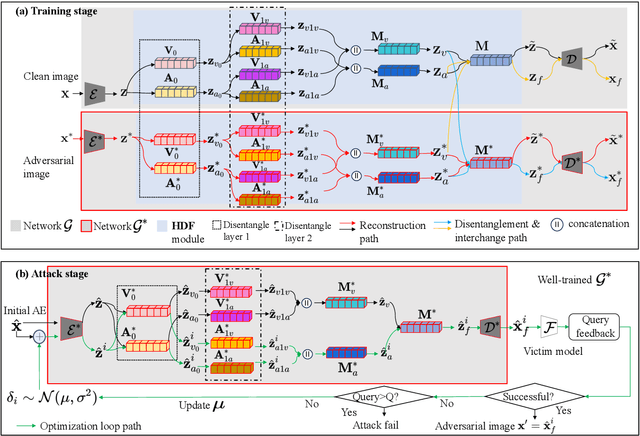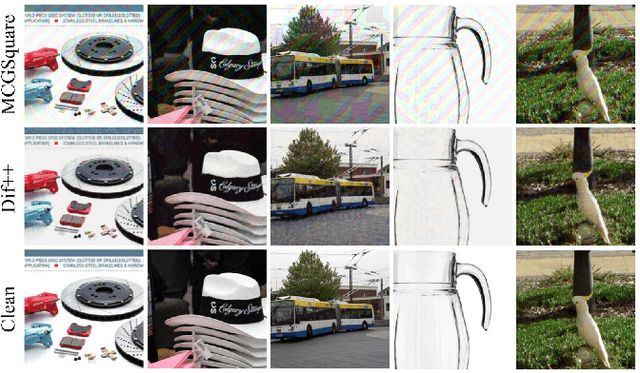Jinyu Tian
Structure Disruption: Subverting Malicious Diffusion-Based Inpainting via Self-Attention Query Perturbation
May 26, 2025Abstract:The rapid advancement of diffusion models has enhanced their image inpainting and editing capabilities but also introduced significant societal risks. Adversaries can exploit user images from social media to generate misleading or harmful content. While adversarial perturbations can disrupt inpainting, global perturbation-based methods fail in mask-guided editing tasks due to spatial constraints. To address these challenges, we propose Structure Disruption Attack (SDA), a powerful protection framework for safeguarding sensitive image regions against inpainting-based editing. Building upon the contour-focused nature of self-attention mechanisms of diffusion models, SDA optimizes perturbations by disrupting queries in self-attention during the initial denoising step to destroy the contour generation process. This targeted interference directly disrupts the structural generation capability of diffusion models, effectively preventing them from producing coherent images. We validate our motivation through visualization techniques and extensive experiments on public datasets, demonstrating that SDA achieves state-of-the-art (SOTA) protection performance while maintaining strong robustness.
Data-Free Universal Attack by Exploiting the Intrinsic Vulnerability of Deep Models
Mar 28, 2025Abstract:Deep neural networks (DNNs) are susceptible to Universal Adversarial Perturbations (UAPs), which are instance agnostic perturbations that can deceive a target model across a wide range of samples. Unlike instance-specific adversarial examples, UAPs present a greater challenge as they must generalize across different samples and models. Generating UAPs typically requires access to numerous examples, which is a strong assumption in real-world tasks. In this paper, we propose a novel data-free method called Intrinsic UAP (IntriUAP), by exploiting the intrinsic vulnerabilities of deep models. We analyze a series of popular deep models composed of linear and nonlinear layers with a Lipschitz constant of 1, revealing that the vulnerability of these models is predominantly influenced by their linear components. Based on this observation, we leverage the ill-conditioned nature of the linear components by aligning the UAP with the right singular vectors corresponding to the maximum singular value of each linear layer. Remarkably, our method achieves highly competitive performance in attacking popular image classification deep models without using any image samples. We also evaluate the black-box attack performance of our method, showing that it matches the state-of-the-art baseline for data-free methods on models that conform to our theoretical framework. Beyond the data-free assumption, IntriUAP also operates under a weaker assumption, where the adversary only can access a few of the victim model's layers. Experiments demonstrate that the attack success rate decreases by only 4% when the adversary has access to just 50% of the linear layers in the victim model.
Anti-Diffusion: Preventing Abuse of Modifications of Diffusion-Based Models
Mar 07, 2025Abstract:Although diffusion-based techniques have shown remarkable success in image generation and editing tasks, their abuse can lead to severe negative social impacts. Recently, some works have been proposed to provide defense against the abuse of diffusion-based methods. However, their protection may be limited in specific scenarios by manually defined prompts or the stable diffusion (SD) version. Furthermore, these methods solely focus on tuning methods, overlooking editing methods that could also pose a significant threat. In this work, we propose Anti-Diffusion, a privacy protection system designed for general diffusion-based methods, applicable to both tuning and editing techniques. To mitigate the limitations of manually defined prompts on defense performance, we introduce the prompt tuning (PT) strategy that enables precise expression of original images. To provide defense against both tuning and editing methods, we propose the semantic disturbance loss (SDL) to disrupt the semantic information of protected images. Given the limited research on the defense against editing methods, we develop a dataset named Defense-Edit to assess the defense performance of various methods. Experiments demonstrate that our Anti-Diffusion achieves superior defense performance across a wide range of diffusion-based techniques in different scenarios.
AdaSin: Enhancing Hard Sample Metrics with Dual Adaptive Penalty for Face Recognition
Mar 05, 2025Abstract:In recent years, the emergence of deep convolutional neural networks has positioned face recognition as a prominent research focus in computer vision. Traditional loss functions, such as margin-based, hard-sample mining-based, and hybrid approaches, have achieved notable performance improvements, with some leveraging curriculum learning to optimize training. However, these methods often fall short in effectively quantifying the difficulty of hard samples. To address this, we propose Adaptive Sine (AdaSin) loss function, which introduces the sine of the angle between a sample's embedding feature and its ground-truth class center as a novel difficulty metric. This metric enables precise and effective penalization of hard samples. By incorporating curriculum learning, the model dynamically adjusts classification boundaries across different training stages. Unlike previous adaptive-margin loss functions, AdaSin introduce a dual adaptive penalty, applied to both the positive and negative cosine similarities of hard samples. This design imposes stronger constraints, enhancing intra-class compactness and inter-class separability. The combination of the dual adaptive penalty and curriculum learning is guided by a well-designed difficulty metric. It enables the model to focus more effectively on hard samples in later training stages, and lead to the extraction of highly discriminative face features. Extensive experiments across eight benchmarks demonstrate that AdaSin achieves superior accuracy compared to other state-of-the-art methods.
Deferred Poisoning: Making the Model More Vulnerable via Hessian Singularization
Nov 06, 2024Abstract:Recent studies have shown that deep learning models are very vulnerable to poisoning attacks. Many defense methods have been proposed to address this issue. However, traditional poisoning attacks are not as threatening as commonly believed. This is because they often cause differences in how the model performs on the training set compared to the validation set. Such inconsistency can alert defenders that their data has been poisoned, allowing them to take the necessary defensive actions. In this paper, we introduce a more threatening type of poisoning attack called the Deferred Poisoning Attack. This new attack allows the model to function normally during the training and validation phases but makes it very sensitive to evasion attacks or even natural noise. We achieve this by ensuring the poisoned model's loss function has a similar value as a normally trained model at each input sample but with a large local curvature. A similar model loss ensures that there is no obvious inconsistency between the training and validation accuracy, demonstrating high stealthiness. On the other hand, the large curvature implies that a small perturbation may cause a significant increase in model loss, leading to substantial performance degradation, which reflects a worse robustness. We fulfill this purpose by making the model have singular Hessian information at the optimal point via our proposed Singularization Regularization term. We have conducted both theoretical and empirical analyses of the proposed method and validated its effectiveness through experiments on image classification tasks. Furthermore, we have confirmed the hazards of this form of poisoning attack under more general scenarios using natural noise, offering a new perspective for research in the field of security.
DAT: Improving Adversarial Robustness via Generative Amplitude Mix-up in Frequency Domain
Oct 16, 2024



Abstract:To protect deep neural networks (DNNs) from adversarial attacks, adversarial training (AT) is developed by incorporating adversarial examples (AEs) into model training. Recent studies show that adversarial attacks disproportionately impact the patterns within the phase of the sample's frequency spectrum -- typically containing crucial semantic information -- more than those in the amplitude, resulting in the model's erroneous categorization of AEs. We find that, by mixing the amplitude of training samples' frequency spectrum with those of distractor images for AT, the model can be guided to focus on phase patterns unaffected by adversarial perturbations. As a result, the model's robustness can be improved. Unfortunately, it is still challenging to select appropriate distractor images, which should mix the amplitude without affecting the phase patterns. To this end, in this paper, we propose an optimized Adversarial Amplitude Generator (AAG) to achieve a better tradeoff between improving the model's robustness and retaining phase patterns. Based on this generator, together with an efficient AE production procedure, we design a new Dual Adversarial Training (DAT) strategy. Experiments on various datasets show that our proposed DAT leads to significantly improved robustness against diverse adversarial attacks.
Short-Term Electricity-Load Forecasting by Deep Learning: A Comprehensive Survey
Aug 29, 2024Abstract:Short-Term Electricity-Load Forecasting (STELF) refers to the prediction of the immediate demand (in the next few hours to several days) for the power system. Various external factors, such as weather changes and the emergence of new electricity consumption scenarios, can impact electricity demand, causing load data to fluctuate and become non-linear, which increases the complexity and difficulty of STELF. In the past decade, deep learning has been applied to STELF, modeling and predicting electricity demand with high accuracy, and contributing significantly to the development of STELF. This paper provides a comprehensive survey on deep-learning-based STELF over the past ten years. It examines the entire forecasting process, including data pre-processing, feature extraction, deep-learning modeling and optimization, and results evaluation. This paper also identifies some research challenges and potential research directions to be further investigated in future work.
From Words to Worth: Newborn Article Impact Prediction with LLM
Aug 07, 2024Abstract:As the academic landscape expands, the challenge of efficiently identifying potentially high-impact articles among the vast number of newly published works becomes critical. This paper introduces a promising approach, leveraging the capabilities of fine-tuned LLMs to predict the future impact of newborn articles solely based on titles and abstracts. Moving beyond traditional methods heavily reliant on external information, the proposed method discerns the shared semantic features of highly impactful papers from a large collection of title-abstract and potential impact pairs. These semantic features are further utilized to regress an improved metric, TNCSI_SP, which has been endowed with value, field, and time normalization properties. Additionally, a comprehensive dataset has been constructed and released for fine-tuning the LLM, containing over 12,000 entries with corresponding titles, abstracts, and TNCSI_SP. The quantitative results, with an NDCG@20 of 0.901, demonstrate that the proposed approach achieves state-of-the-art performance in predicting the impact of newborn articles when compared to competitive counterparts. Finally, we demonstrate a real-world application for predicting the impact of newborn journal articles to demonstrate its noteworthy practical value. Overall, our findings challenge existing paradigms and propose a shift towards a more content-focused prediction of academic impact, offering new insights for assessing newborn article impact.
DifAttack++: Query-Efficient Black-Box Adversarial Attack via Hierarchical Disentangled Feature Space in Cross Domain
Jun 05, 2024



Abstract:This work investigates efficient score-based black-box adversarial attacks with a high Attack Success Rate (ASR) and good generalizability. We design a novel attack method based on a \textit{Hierarchical} \textbf{Di}sentangled \textbf{F}eature space and \textit{cross domain}, called \textbf{DifAttack++}, which differs significantly from the existing ones operating over the entire feature space. Specifically, DifAttack++ firstly disentangles an image's latent feature into an \textit{adversarial feature} (AF) and a \textit{visual feature} (VF) via an autoencoder equipped with our specially designed \textbf{H}ierarchical \textbf{D}ecouple-\textbf{F}usion (HDF) module, where the AF dominates the adversarial capability of an image, while the VF largely determines its visual appearance. We train such autoencoders for the clean and adversarial image domains respectively, meanwhile realizing feature disentanglement, by using pairs of clean images and their Adversarial Examples (AEs) generated from available surrogate models via white-box attack methods. Eventually, in the black-box attack stage, DifAttack++ iteratively optimizes the AF according to the query feedback from the victim model until a successful AE is generated, while keeping the VF unaltered. Extensive experimental results demonstrate that our method achieves superior ASR and query efficiency than SOTA methods, meanwhile exhibiting much better visual quality of AEs. The code is available at https://github.com/csjunjun/DifAttack.git.
Regroup Median Loss for Combating Label Noise
Dec 11, 2023



Abstract:The deep model training procedure requires large-scale datasets of annotated data. Due to the difficulty of annotating a large number of samples, label noise caused by incorrect annotations is inevitable, resulting in low model performance and poor model generalization. To combat label noise, current methods usually select clean samples based on the small-loss criterion and use these samples for training. Due to some noisy samples similar to clean ones, these small-loss criterion-based methods are still affected by label noise. To address this issue, in this work, we propose Regroup Median Loss (RML) to reduce the probability of selecting noisy samples and correct losses of noisy samples. RML randomly selects samples with the same label as the training samples based on a new loss processing method. Then, we combine the stable mean loss and the robust median loss through a proposed regrouping strategy to obtain robust loss estimation for noisy samples. To further improve the model performance against label noise, we propose a new sample selection strategy and build a semi-supervised method based on RML. Compared to state-of-the-art methods, for both the traditionally trained and semi-supervised models, RML achieves a significant improvement on synthetic and complex real-world datasets. The source code of the paper has been released.
 Add to Chrome
Add to Chrome Add to Firefox
Add to Firefox Add to Edge
Add to Edge